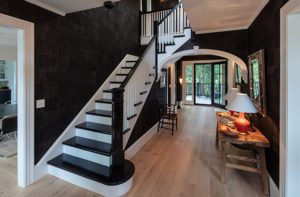Timeless Transitional
May 10, 2016
A Marblehead Neck home speaks the native vernacular with a sophisticated accent.
Text by Charlotte Safavi Photography by Michaell J. Lee
Getting in on a spec house before ground is broken has its upside. Such was the case when a husband and wife acquired architectural plans to build a 3,800-square-foot home on a quarter-acre lot in Marblehead Neck, Massachusetts. The parcel wasn’t large, but its location was perfect. “It has a great view of Marblehead Harbor,” says the wife. “It’s constantly changing, with fishing boats and sailboats coming and going. There’s always movement on the water. It’s gorgeous.”
Local bylaws and zoning codes meant the couple couldn’t make substantial changes to the exterior architecture, but they were pleased to see that the plans included details such as gambrel rooflines, double-hung windows, and white cedar shingles that were right in step with the surrounding homes.
They were free to alter the interiors, however, and they engaged architect Rob Bramhall to help them create a space that met their needs. “The inside was always about maximizing the waterfront views, with lots of windows,” says Bramhall. “The homeowners wanted to add a layer of detail—the kind of detailing you’d find in an old New England cottage, but with a new level of sophistication.”
In the foyer, simple and elegant paneled walls set the tone and define the space, which is washed with natural light. Directly across the entry, via a cased opening into the main living area, is a large window with a harbor view. “When you’re standing outside the house, you can see the water everywhere, so when you come inside, you’re immediately reconnected to it,” says Bramhall.
Other architectural elements include coffered ceilings, some with beadboard detail, creating spatial definition on the main living area’s open floor plan; flat-paneled doors with high-contrast rubbed bronze hardware; and clean-lined, more contemporary inset cabinetry.
The main living area runs mostly on a rectangular plane, its length overlooking the scenic harbor. It also has a double living room, separated by another cased opening, with a mosaiced fireplace surround and built-ins at one end and an open kitchen at the other.
“The homeowners love to cook and entertain,” says kitchen designer Andrea Avery. “They wanted something stylish, but with a comfortable beach-cottage feel.”
The kitchen sits just off a large glassed-in space that was originally intended to be the family room. In the new plan, that space became the dining room. In designing the kitchen, Avery took advantage of the dining room’s abundance of natural light and waterfront views. “I put the sink in the island, so that when the homeowner is prepping food or cleaning up, she can look outdoors,” she says. The island, which holds up to five bar chairs for casual dining, has a pair of decorative legs and a granite countertop.
Interior designer Julia Cutler suggested the kitchen’s backsplash of glazed subway tile. Cutler, who had met the homeowners at a lively dinner party hosted by mutual friends, knew her clients entertain often, so she understood the importance of designing the house and adapting its layout for that purpose. “We don’t have dinner parties for four,” says the wife. “We’re typically bursting at the seams! We love to open up our home to friends and family from all over.”
Key to the interior floor plan, Cutler says, was placing the dining room in its current space, and moving the family room to the basement level, which also holds a wine cellar and tasting room. As empty nesters, the homeowners don’t need a big family room upstairs, she explains. “Instead, they now have a double living room for entertaining on the main level, as well as a designated dining room.”
In this new layout, the dining room opens out onto a swimming pool and bluestone patio, also set up for entertaining with a pool house and outdoor pizza oven, creating a nice in-and-out flow for parties. The relaxed landscaping by James Kelliher, using hardy native plants, complements that vibe.
As much as the homeowners enjoy entertaining, they like their quiet time, too. “They wanted a space that was comfortable and easy, yet also serene and quiet, a Zen-like place,” says Cutler. When it comes to creating a calm space, color is one of the most important factors. The wife had shown Cutler a pretty piece of stone that she had responded to, loving how it made her feel. “The stone—a granite—ended up on the kitchen’s island and countertops,” says the designer. “It’s really beautiful, and resembles the colors and patterns of sand and water.”
Pulling from the granite’s blue grays, soft taupes, and sandy beiges, Cutler selected fabrics that reflected these neutral, nurturing shades. To maintain sufficient interest and to provide subtle contrast, she brought in a mix of patterns and textures.
“I started with the tête-à-tête settee and its fabric, an oval-and-dot geometric motif in a cotton blend,” says Cutler of the tailored, yet shapely seating option that bridges the double living room. “From that piece on, I layered in interesting textiles, along with a mix of furniture that accommodated social gatherings.”
Textiles throughout the house include upholstery in petite herringbone weaves, textural gridded velvets, and leather and Ultrasuede, as well as cut-velvet throw pillows and silk-and-wool Tibetan area rugs. All come together to create a comfortable environment with a hint of luxe. Reflective surfaces like the mini-mosaic fireplace surround, the capiz-shell feature wall in the powder room, and the bejeweled glass in the kitchen’s twin light pendants add sophisticated glamour, while being perfectly at home in the coastal setting.
Furniture shapes are clean-lined with a relaxed feel, and the metallic mix includes rubbed bronze and wrought iron, but is mainly silver in tone. The woods are either beach-rustic or espresso-hued in finish, like the stained walnut floors.
“When it comes to style, I’m from New York and love a more transitional, not traditional, look,” the wife says. “Still, I wanted to keep the integrity of where I live, that historic New England cottage vibe, but at the same time, have the interiors showcase the level of sophistication and contemporary flair that I prefer.”
Thanks to a skilled design team, the spec-house has metamorphosed into a home that suits its owners down to the last detail. •
Architecture: Rob Bramhall, Rob Bramhall Architects
Interior design: Julia Cutler, Julia Cutler Interior Design
Builder: Tom Jacobs, Jacobs Construction-Remodeling
Landscape design: James Kelliher, James Kelliher Garden Design
Share
![NEH-Logo_Black[1] NEH-Logo_Black[1]](https://www.nehomemag.com/wp-content/uploads/2022/08/NEH-Logo_Black1-300x162.jpg)




















You must be logged in to post a comment.